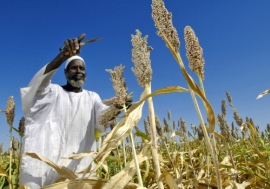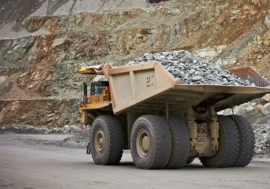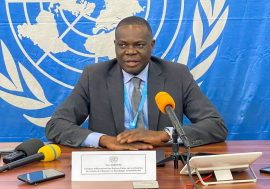What does the ‘Doha Climate Gateway’ mean for Africa?
A UN climate change conference in Doha, Qatar, concluded in December 2012 with a new agreement called the “Doha Climate Gateway.” Its major achievements included the extension until 2020 of the 1997 Kyoto Protocol on reducing greenhouse gas emissions, as well as a work plan for negotiating a new global climate pact by 2015, to be implemented starting in 2020.
Despite these commitments, the Doha conference made only limited progress in advancing international talks on climate change, and failed to set more ambitious goals for reducing greenhouse gas emissions.
That failure increases the risk of a rise in average global temperatures by 2 degrees Celsius by the end of this century. The Emissions Gap Report 2012 by the UN Environment Programme (UNEP) stresses that if the world does not accelerate action on climate change, total yearly greenhouse gas emissions could rise to 58 gigatonnes by 2020 (compared to 40 gigatonnes in 2000), far above the level scientists say would likely keep temperature increases below 2°C.
Studies by the World Bank indicate that even with the current commitments and pledges fully implemented, there is roughly a 20% likelihood that temperature increases will top 4°C by the end of this century, triggering a cascade of cataclysmic changes, including extreme heat waves, declining global food stocks and a rising sea level, that will affect hundreds of millions of people.
All regions of the world will suffer if this happens, but the poor will suffer the most, and sustainable development in Africa will be set back considerably. Severe droughts in the Horn of Africa in 2011 and in the Sahel region in 2012 alarmingly highlighted Africa’s vulnerability.
Not-so-fast finance
African countries are among those least likely to have the resources to withstand the adverse impacts of climate change. At the 2009 Copenhagen negotiations, developed countries committed to pay $100 billion per year by 2020 into the Green Climate Fund to help developing countries implement adaptation and mitigation practices to counter climate change. They also pledged to deliver $30 billion as “fast start finance” by 2012.
Disappointingly, a report by the African Climate Policy Centre of the UN Economic Commission for Africa shows that of the $30 billion promised in 2009, only 45% has been “committed,” 33% “allocated” and about 7% actually “disbursed.”
At the Doha conference, Germany, the UK, France, Denmark, Sweden and the EU Commission announced financial pledges totalling approximately $6 billion for the period up to 2015. Most developed countries did not make pledges. African countries thus left Doha with little more than they already had.
Bottom-up approach
Cost-effective measures need to be taken without delay to mitigate the effects of climate change in Africa. Fortunately, there are already many examples in Africa of bottom-up approaches that directly address national needs.
In Togo, for example, a water reservoir project provided accurate data for rehabilitating water dams. This data and expertise gained during the rehabilitation helped the government develop a proposal for rehabilitating all other water reservoirs in Togo. As a result, access to water has improved for most local communities, with rainwater harvested from rehabilitated dams available for domestic and agro-pastoral consumption.
In Seychelles, a rainwater harvesting project in schools gave students a practical demonstration of adaptation to climate change, with harvested water used for school gardens, cleaning and flushing toilets. It also enabled the schools to save up to $250 per month on water bills, money that could be invested in other areas such as teaching and learning resources. Legislation is now under consideration to include rainwater harvesting systems in building codes.
However successful such initiatives may be, their scale is limited. Sizable increases in capital are needed to expand the reach of such adaptation projects. Yet it is unclear whether Africa will ever have sufficient funds to enable the most vulnerable people to adapt to the negative impacts of climate change.
Before the Doha conference, developing countries elaborated a common position that included the desire for a new climate treaty, financing and new technologies to help them make the transition to cleaner, “green” economic practices. “We all have a responsibility in some way to address climate change in order to achieve sustainable development,” said Ali Mohammed, Kenya’s permanent secretary in the ministry of environment and mineral resources. “Africa, small island developing states and least developed countries continue to suffer most from the effects of climate change.”
Priority for adaptation
Greater adaptation efforts in Africa are essential, and they should be supported financially and politically by many different stakeholders in Africa and around the globe. Not only should the process of long-term climate financing from developed countries be accountable and transparent, but it should also be directed first and foremost to the most vulnerable developing countries.
There also needs to be a better balance. Currently, “fast start” finance, however slow in arriving, is largely directed toward “mitigation” projects, which tackle the causes of climate change, such as by reducing greenhouse gas emissions. Against the 62% allocated for mitigation projects, only 25% is destined to finance “adaptation” actions, which are intended to minimize the consequences of actual and expected changes in the climate. The remaining 13% goes to countering deforestation, which can also be counted as mitigation, since forests help absorb greenhouse gases in the atmosphere.
Seyni Nafo, the spokesperson of the African Group at the Doha talks, insisted, “In Africa, we need to know how much is new, where it is coming from, and whether it will be directed to the adaptation projects that are desperately necessary.”
Positive steps
Despite the limited advances on financing, African countries gained five positive developments from the Doha conference:
- The formal extension of the Kyoto Protocol, with continued access to carbon-trading market mechanisms such as the Clean Development Mechanism.
- Financing for the formulation and implementation of national adaptation plans for all particularly vulnerable countries, not just the small island developing states and least developed countries, as previously.
- The agreement to develop an international mechanism to address loss and damage, which would support countries affected by slow-onset events such as droughts, glacial melting and rising sea levels.
- A programme for climate change education and training and for the creation of public awareness to enable the public to participate better in climate change decision-making.
- The agreement to assess developing countries’ needs for green technology, as well as a pledge that no unilateral action will be taken on the development and transfer of technologies.
Effectively meeting the challenges of climate change will require a compromise of monumental proportions by all countries. But climate change will not wait for the adoption of binding international climate change agreements. Nor should individual governments, businesses and others hesitate to take bottom-up action and support local grassroots initiatives.
Richard Munang is a policy and programme coordinator for the Africa Climate Change Adaptation Programme of the UN Environment Programme, and Zhen Han is an environmental policy graduate fellow of the Council of World Women Leaders at Cornell University in the US.




















